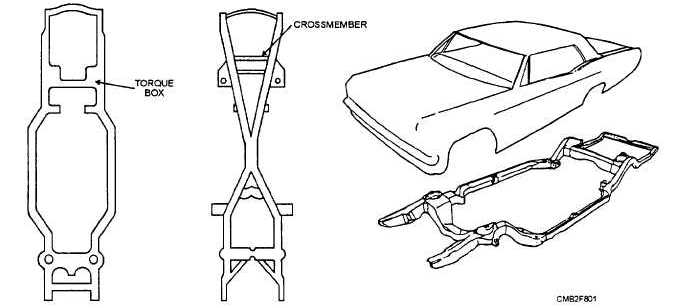CHAPTER 8 AUTOMOTIVE CHASSIS AND BODY
INTRODUCTION
Learning Objective: Identify the types of automotive suspension and steering systems, their components, their functions, and maintenance requirements. State the characteristics and basic construction of a tire. Describe the procedures for maintaining tires, wheels, and wheel bearings. State the purpose of each wheel alignment setting. Describe the different types of equipment used during wheel alignment service. Describe the procedures for repairing and refinishing automotive bodies.
The automotive chassis provides the strength necessary to support the vehicular components and the payload placed upon it. The suspension system contains the springs, the shock absorbers, and other components that allow the vehicle to pass over uneven terrain without an excessive amount of shock reaching the passengers or cargo. The steering mechanism is an integral portion of the chassis, as it provides the operator with a means of controlling the direction of travel. The tires grip the road surface to provide good traction that enables the vehicle to accelerate, brake, and make turns without skidding. Working in conjunction with the suspension, the tires absorb most of the shocks caused byroad irregularities. The body of the vehicle encloses the mechanical components and passenger compartment. It is made of relatively light sheet metal or composite plastics. The components which make up the chassis are held together in proper relation to each other by the frame.
FRAMES
Learning Objective: Describe the function, construction, and types of frames used on wheeled vehicles.
The separate frame and body type of vehicle construction (fig. 8-1) is the most common technique used when producing most full-sized and cargo vehicles. In this type of construction, the frame and the vehicle body are made separately, and each is a complete unit by itself. The frame is designed to support the weight of the body and absorb all of the loads imposed by the terrain, suspension system, engine, drive train, and steering system, and the body merely contains and, in some cases, protects the cargo. The body generally is bolted to the frame at a few points to allow for flexure of the frame and to distribute the loads to the intended load-carrying members. The components of this type of frame are as follows (fig. 8-2):
The SIDE MEMBERS or rails are the heaviest part of the frame. The side members are shaped to

Figure 8-1. - Separate frame and body.
Continue Reading